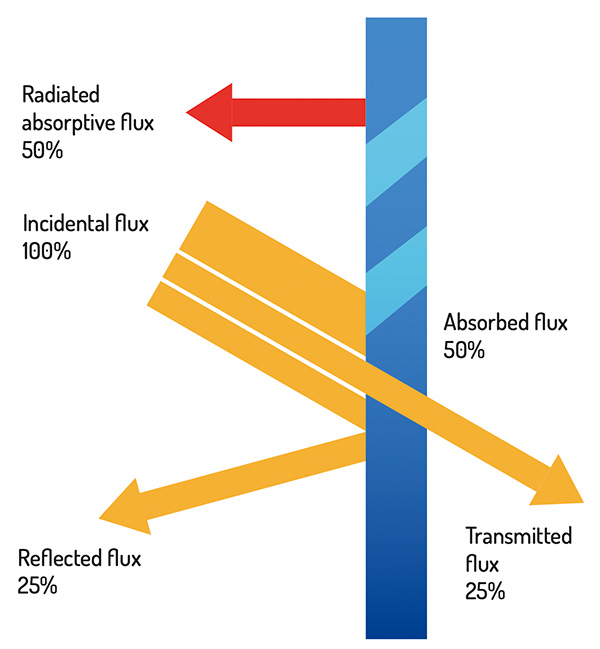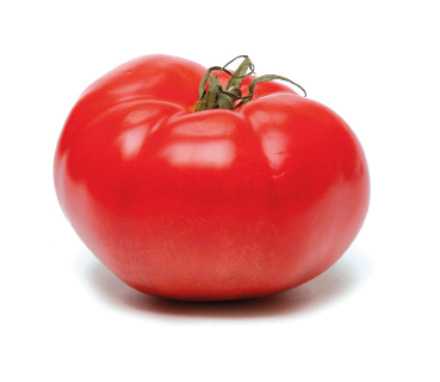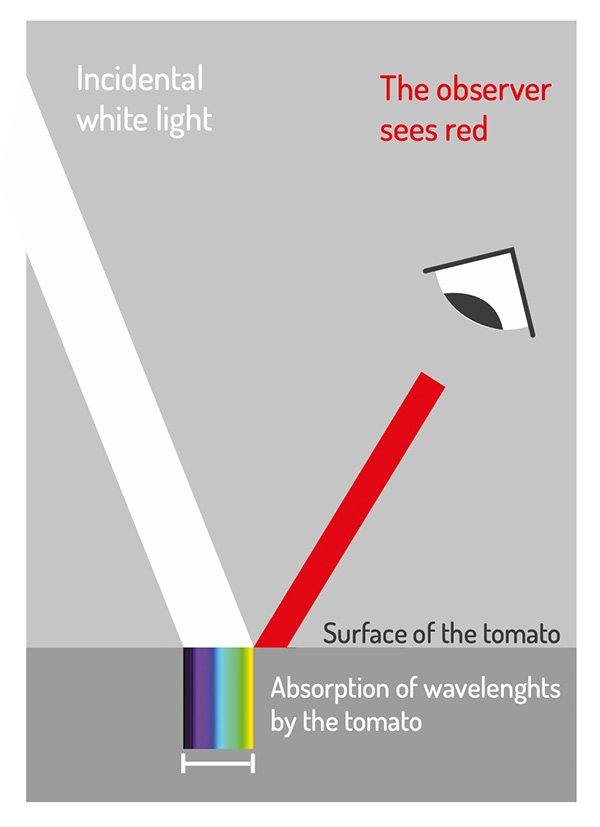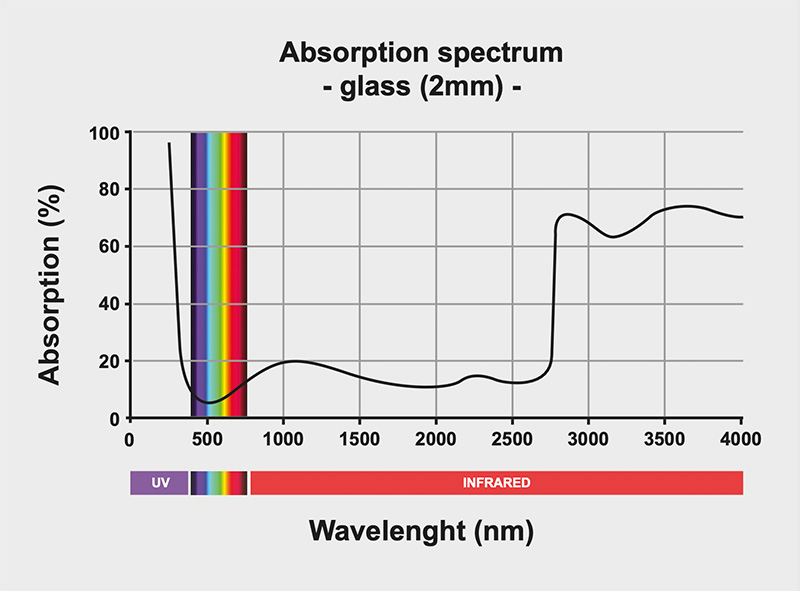As you well know, humans see in color, especially during the day.
If you see an object, it is only because it is illuminated by a light source and its color is detached from that of its background, i.e. the environment in which it is located. The boundaries of objects are simply the differences in their colors and contrasts, and thus, in its setting, humans are able to distinguish several forms, in order to analyse and interpret what is happening.
People see what is reflected from the light, and so, the color of a surface depends on how it is illuminated and in our position as an observer.
If you look at objects or people in a normally-lit room, you see the result of the reflection of light on these objects.
What must be kept in mind at this stage, is that all matter on the planet (human skin, leaves, the sea, metal, stone etc.) will react differently when it is illuminated. Light can be reflected on all matter; it can be completely absorbed, or partially-absorbed and partially-reflected, and can be seen as different colors. We will look at this in more detail later on.
The white, natural light coming from the sun is actually composed of different colors.
You may remember this experiment where a luminous ray is passed through a prism and the colors of the rainbow appear.
This simply shows how the sun’s «white» light is composed of several colors. Each color is an electromagnetic wave with a well-defined wavelength. Depending on the size of the wavelength, it will not propagate at the same speed through the prism; and in having a specific shape, it will deflect the wavelength’s output.
Furthermore, the part that humans can see with their eyes, known as the «visible spectrum», is only a very small part of the complete electromagnetic spectrum, however, we will come back to this later.
We can see these colors because our eye is sensitive only to rays whose wavelength is roughly between 0.38 and 0.75 millionths of a meter, in other words, between 380nm (violet) and 750nm (red).
Between these 2 values, we find the different shades of the colors of the rainbow.
According to the value of this wavelength, we perceive these rays as a light of a certain color. Thus, if we look at a lamp that emits light with a wavelength 0.4 μm (400nm), we will see it as violet. If the lamp emits a shorter wavelength (in the ultraviolet), we will not see anything, because it is below the threshold of the eye’s sensitivity. This is the case for wavelengths greater than 750nm.

Among these colors, 3 are primary colors: Red, Green and Blue.
![]()
We call these 3 colours primary colors, because it is possible to create all the colors of the rainbow from them.
Primary colors are mixed to get secondary colors. For example, when red and green are mixed, we get yellow (this is called additive synthesis).
Secondary colors: cyan, magenta, yellow.
![]()
Finally, tertiary colors can be obtained by mixing a primary color and a secondary color.
Tertiary colors: orange, chartreuse, spring green, azure, violet, rose (RGB).
![]()
Please note :
As for the colors of the rainbow, if we add the primary colors, red, green and blue together, it will create white.
Black is the absence of color.

At this point, it is important to understand the connection between the colors that make up the white light of the sun and the human eye.
We have seen previously that the visible spectrum extends roughly 380 to 750nm, which is an extremely small wavelength.
But then why would the human eye only be sensitive in this frequency band?
In fact, inside the human eye, there are cones and rods.

These rods are cells that are sensitive to light intensity: they translate for our brain the degree of light radiance.
However, they cannot differentiate two equally bright colors. In addition, rods are much more sensitive than cones. In fact, when we are in a weakly-lit environment, we have difficulty distinguishing colors and thus, objects appear grayish; in this situation, the light is sufficient to stimulate the rods, but not the cones. At night, it is the rods that allow us to see.
Cones are cells that react to color. They allow the differentiation between two shades. There are ten times less cones than rods. Three types of cones have been discovered, each being sensitive to a certain range of wavelength: the «S» cones are quite sensitive to blues, the «M» to greens and the «L» to reds.
Humans are therefore equipped with cells sensitive to the three primary colors: red, green and blue. It is also in relation to our reference as being human beings, that we decreed that these three colors were primary colors.
And when we speak of a «visible» light spectrum, we are talking about a visible spectrum in relation to human capabilities. Other living species may have a «visible» spectrum different from ours, and have cells that are sensitive to other wavelengths.
In summary, the light that comes from an object that we observe (emitted or diffused light) will penetrate our eye through the pupil (responsible for regulating the entering luminous flux), crossing the lens then the eyeball, and will eventually stimulate the nerve cells lining the retina, in the back of the eye, that is, the cones and rods. Each type of cone is more or less stimulated according to its type (S, M or L) along with the composition of the light received. This is the set of signals that are interpreted by the brain to match a color. And so, yellow light will stimulate cones M and L (which despite their sensitivity in red and green, are sensitive to wavelengths in yellow), but not S (sensitive to blues). The information «green» + «red» will be translated as «yellow».
Things to know (1):
About 80% of cones line the central area of the retina, or fovea. This area corresponds to where the center of the image is formed. At night, in the dim lighting of the stars and a quarter-moon, we cannot distinguish objects that are right in front of us. In fact, the fovea do not contain rods (100% of the rods are placed on the retina), and therefore do not react to low light.
In order for our brain to «understand» what is in front of us, we need to move our eyes, or «sweep» the scene so that the rods, present around the fovea, «see» what interests us. This method is well known in the military.
Things to know (2):
It has been previously indicated that the environment has a strong influence on our perception of colors.
To demonstrate this, here is just one example of contrasts in brightness.
Our eye adapts to the average light intensity of a particular area. In a very bright environment, our pupil closes to «regulate» the flow of light received. In the dark, the pupil opens wider. Immediate consequence: the same color will be perceived as darker on a light background than it is on a dark background.
In the example below: the gray dot in the center appears lighter to the left than to the right when in fact, it is exactly the same color.

This also applies to contrasts of saturation or tones.
In order to do this, we must first understand a few concepts…
All matter (living, material etc.) reacts to light.
For example, if a ray of light hits an object, it can:
1) Reflect part of this light
The light hitting the object bounces off the surface towards our eye. Most things around us behave like this: a table, a piece of clothing, fruit, as well as the moon or any planet seen from the Earth.
The ratio of reflected energy to incidental energy is called reflectance.
2) Absorbing a part of these light rays
The ratio of absorbed energy to incident energy is called absorbance.
3) Transmitting part of these light rays
Is partial but more or less faithful. The received light passes through the object’s matter, is filtered, and continues its way towards our eye. A colored plastic filter, a slide, spectacles and sun-glass lenses are a few examples.
The ratio of transmitted energy to incident energy is called transmittance.
4) Re-emitting part of the light absorbed in the form of far-infrared radiation
In a steady system (the absorbed radiation and the temperature of the material are constant). The ratio of the energy emitted to the energy absorbed is called the emissivity coefficient.
And of course, some materials lit by certain rays can do all of this at once.
And so, each material, has its own properties and therefore reacts differently according to the wavelength of the light it receives.
Note :
The object itself may emit light: this is the case of a light bulb, the flame of a candle, the sun, a LED etc.

Let’s take the case, for example, of a tomato. If we illuminate it with white light, the properties of the tomato will make it absorb the blue and green rays (that is, the part of the spectrum from purple to orange), which then reflect the red rays that reach our eye. This is why humans see a red tomato during the day.


If, on the other hand, we now light it up with a green or blue light (which do not contain a red component), the tomato will look black to us because it will have absorbed all the rays and nothing will have been reflected towards our eye.
We gave an example using a ray of light, however, this functions in exactly same way as for any type of beam on the full spectrum. Objects can also emit or reflect wavelengths that are invisible to us. It’s just a matter of interaction between the matter and the wavelength of the incidental ray.
We will also see that for some applications, it is useful to «illuminate» by infrared, i.e. an infrared transmitter will illuminate a setting (nothing is seen to the naked eye) and use a sensitive infrared receiver, which will then recover the reflected rays, in the exact same way as the human eye which recovers the rays of light reflected by the object being looked at.
The visible part of the electromagnetic spectrum (by humans), which we saw earlier, is actually only a minute part of the full spectrum.
From either side of the visible spectrum there are different bands of frequency containing different properties and uses. We do not see these waves, but we can feel a few of them:
By going towards higher frequencies (thus shorter wavelengths), we will first find the Ultra-violet rays (UV-a and UV-b produced by the sun, we can’t see them but they make us tan and can be very dangerous for the skin and eyes!). Next, we find X rays that serve especially in the medical field and finally, Gamma rays.
As we move towards lower frequencies, Infra-red is found initially, which can be sub-divided into VNIR / SWIR bands for near infrared and MWIR / LWIR bands which correspond to thermal. We can feel radiation in the form of heat. Next, we find the TeraHertz band which links the field of photonics with radio waves. The THz is used, for example, in airport doorway-detectors (to detect weapons). Next, there are microwaves which have numerous applications, including radar. This then brings us to radio and TV waves, used for mobile telephony, radio or TV.
All these waves are not visible to humans, but they are «visible» by receivers or sensors.
For example, there are image sensors in the visible spectrum (that is, in sensors that are used to make cameras), however, there are also image sensors in UV, infrared, Thz etc. which serve in manufacturing cameras for which the result must be adapted for humans to be able to visualize and interpret these images.
Depending on the issue needing to be solved with a vision system, we will start by studying the spectral signature of different matter in order to find a frequency band in which it reacts and then building the complete system permitting it to be «seen» so as to detect the item in the desired frequency band.
For example, here is a graph illustrating the spectral signatures of the predominant natural surfaces:

What this graph teaches us:
That snow has a strong reflectance in the visible spectrum but is very weak in the mid-infrared;
That vegetation reflects green (approx.530nm in wavelength) but also has a strong reflectance in the near- infrared; and so, if we illuminate a leaf in the near infrared, it will appear white on a screen;
That water reflects part of the visible light but completely absorbs the infrared; so if we illuminate a setting with an infrared source, the water will appear black on a screen.
Note : each type of plant or tree possesses a unique spectral signature which depends on its growth, as well as its environmental conditions and constraints (humidity, temperature, etc.)
In the case of glass:
Glass has the characteristic of having a high transmittance for solar radiation (visible light and near-infrared) but a low transmittance for far-infrared radiation; in other words, glass blocks far-infrared light rays by absorbing them. Thus, if you see a person with glasses in the far-infrared (thermal), you will see color gradients in the areas of their body that give off heat whilst their glasses will be black.
Glass is therefore ideal for creating a greenhouse effect: it allows the sun’s rays to pass through and trap infrared rays re-emitted by other matter. In this diagram, we see how glass absorbs a part of the UV and far-infrared rays whilst letting the visible spectrum waves pass in the near-infrared.

In the military field, optronic systems using different frequency bands are used according to the operating conditions, in particular for detection, recognition and identification. On the other hand, camouflage techniques, whose goal it is to delay images for a maximum detection time, have benefited from enormous technological progress, whether it be in the dissimulation of the individual fighter, of vehicles or the reduction of the electromagnetic signature forces (e.g. infrared signature).
There is intense competition in this domain with more and more powerful means of detection (radar, infrared, thermal) with technologies that reduce the electromagnetic signatures of people and equipment. And thus, the eternal duel between the sword and the shield continues…